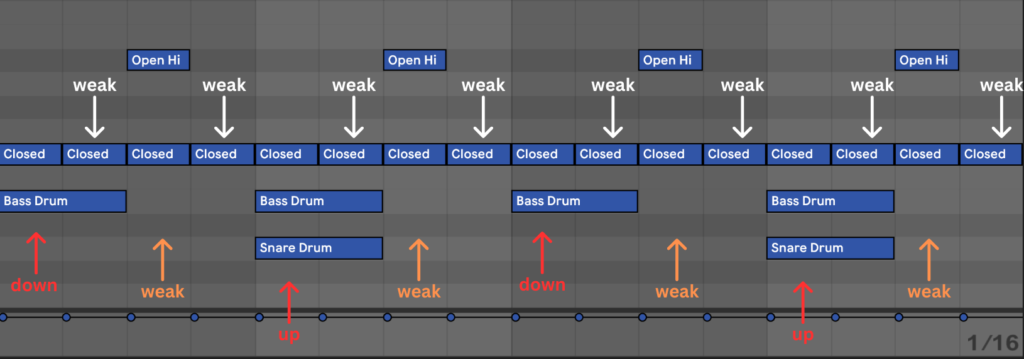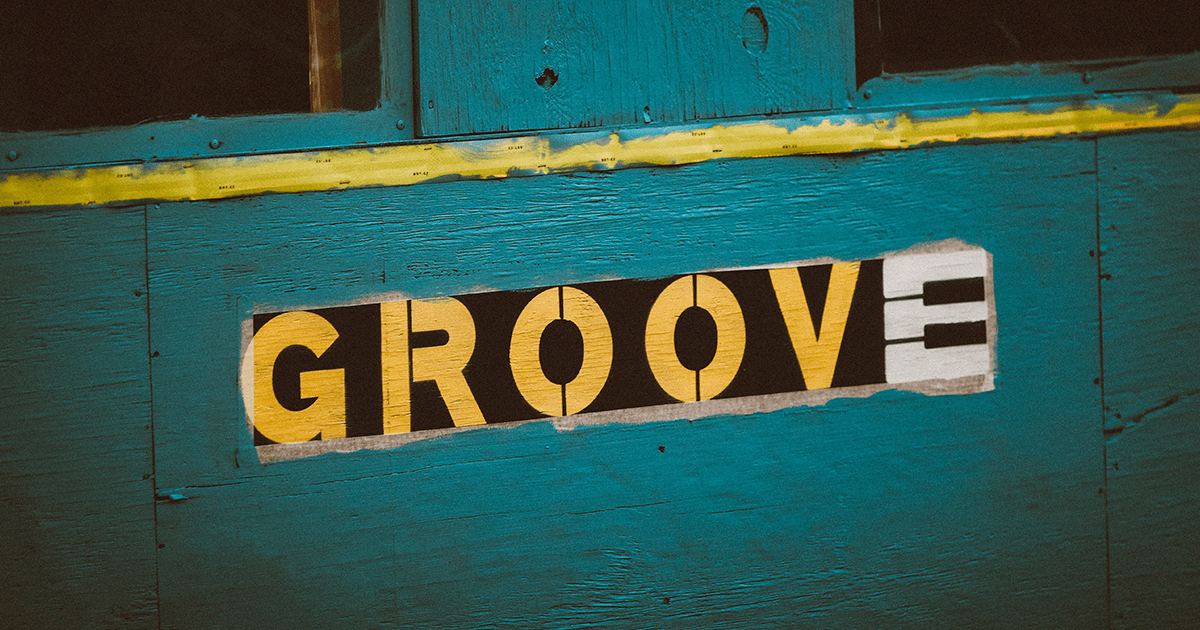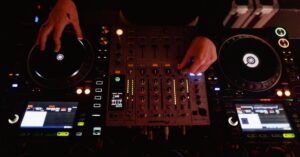What is Groove ?
The term ‘groove’ is frequently used in musical descriptions, but many people are unaware of its true definition.
If you’re a techno fan, you’ve probably heard of sub genres like ‘groovy techno’ or ‘hardgroove techno’. They have a thing for that enticing groove, and who can blame them? Groove is that magnetic force that pulls at your soul, urging you to dance like no one is watching – therefore that specific something that distinguishes good tunes from bad ones. But what is groove exactly?
The Cambridge dictionary gives a similar definition of groove: ‘a musical rhythm that is enjoyable and makes you want to move or dance‘ 1
Even while I agree with these concepts in general, it is still unclear what groove is all about, and I believe there is more to it than that. This post seeks to shed some light on the subject and demonstrate how to add groove to your productions.
As most descriptions of groove show, groove is often about a feeling or a personal urge to move. All these descriptions are rather subjective perceptions and do not really describe the underlying concept of groove. Therefore, I find the philosophical characterisation of Evan Malone, who is a researcher at the State University of New York, very appealing. He claims that there are two hypotheses about groove: 2
Goove as feel
The first of these is ‘groove as a feel’. This popular theory is held by some musicologists and describes the musical quality resulting from the interplay of different musical nuances as the ‘feel of the music’. In doing so, he describes musical nuances as extremely fine features of a musical performance that are so subtle that they can hardly be put into apt words.Examples of musical nuances are: One note slightly off-pitched, or one note slightly louder than the previous, or one note slightly off the grid (microtiming). Microtiming plays the most important role here and is mainly responsible for the feeling of the music.
Microtiming
Microtiming is the minimal timing deviation of individual notes from the metre. This gives musicians the ability to create a ‘push feel’ or ‘pull feel’ depending on whether the notes are played slightly before or after the actual beat. For example, with identical notation, a punk drummer might place the snare hits slightly before the beat, creating an effect that seems to push the music forward, while a funk drummer might place the same snare hits slightly behind the beat (giving it a more relaxed feel). The result of these differences is the sense of rhythm or groove. These differences often happen on such a small time scale that they cannot be captured in the notes. Especially in jazz, these microtimings play an enormously important role and are largely responsible for the so-called swing.
Groove as movement
The ‘groove as movement’ approach is exclusively about the feeling that is triggered in the listener by the music. It is considered more as a psychological phenomenon linked to deviating objective characteristics of the music than ‘groove as a feel’. In the studies on this, the subjects mentioned, for example: Syncopation, high levels of percussiveness, and clarity in the lower frequencies.
Syncopation
In music theory, syncopation is an effect that interrupts or disrupts the regular rhythmic or harmonic flow of a passage in a composition.
Syncopation occurs when the accent is on a weak beat instead of a strong one, or when a rhythm is split between two different beats. This can create tension and climaxes in music and is often used to make a melody or rhythm more interesting and complex.
One of the most common forms of syncopation is the ‘syncopated rhythm’, where the accent is on a weak beat. In the typical 4/4 time signature, the heavy beats are 1 and 3, the weak beats are 2 and 4.

Here is a representation of the strong and weak beats based on the classic house pattern. The strongest beats are 1 and 3, the so-called down beats.The weaker beats 2 and 4 are also called up beats. The off-beat between the beats where the open hi is, here in orange, is also a weak beat, but still stronger than the 16th notes surrounding it.
To create syncopation, you have to be careful to accentuate or emphasise the weak beats. By emphasising the weak beats, the flow of the rhythm is somewhat interrupted and deviates from our brain’s expectation. It creates a kind of tension and release. The listener expects the emphasis to be on the strong beat – and is instead surprised by the emphasis on the weak beat.
Another form of syncopation is so-called ‘cross-rhythms’, in which two different rhythms are played simultaneously. This can be achieved by having one instrument play a steady pattern while another instrument plays a syncopated pattern on top of it.
This makes the music more complex and interesting, as the listener’s ear is constantly torn between the two different rhythms.
How to implement groove into your productions
Since techno is primarily music for dancing and is mainly heard in clubs, groove is essential if you want to get people dancing. In my opinion, groove is also an important part of the very first origins of techno and probably one of the recipes for the genre’s success. Therefore, I would like to show you some possibilities of how you can incorporate groove into your productions with the help of your DAW.
Humanize
In a band with many musicians, each player plays according to his or her own feelings, giving each instrument a unique flavour. As the different instruments diverge from the grid and reveal microtiming variances, this generates a human groove. Because we, as techno producers, are the complete band on our own, we must ensure that every piece we are programming fits into the rhythm and does not sound too mechanical, which would otherwise be the case owing to the quantisation of the DAW.
Groovepools
The easiest way to implement this in Ableton would be via the so-called groovepools (other DAWs certainly have this feature as well, it may just be called something else). With the help of groovepools, microtiming changes can be applied very easily. Common grooves are those of classic drum machines like the Roland 909 or the Akai MPC, which are celebrated for their characteristic swing.
Alternatively you can just move around the midi clips manually and try to find the perfect groove. Especially delaying the weak beats and leaving the strong beats on grid will give the typical Jazzy-swing feeling.

You can also create and save your own grooves with groovepools. You can save the groove from any audio sample that has a groove. For example, you can extract a groove from a recording that you created yourself, or you can select a drum break that you find particularly appealing and extract the groove with a single click. Experimenting with uncommon rhythms and grooves, such as complex West African drum patterns for example, excites me, as it allows you to develop your own small collection of grooves. By the way: you can use the grooves on audio clips as well as MIDI recordings.
Velocity
Velocity, like microtiming, can be employed to add accents and ‘humanity’ to tracks. A human drummer does not play every beat at the same volume, but rather varies somewhat from beat to beat. You may mimic this behaviour with velocity and add dynamic to the track, making the music less static and robotic. You may also use this as a tool to generate syncopation by emphasising the weak beats or off-beats.
Delay (syncopation)
Delays and echoes are essential effects in techno and not without reason. (You can slap a decent delay and reverb on any sound and you will basically have techno lol)
Simply put, a delay is a time-based audio effect that repeats the original sound source. You can use a delay to produce groove and syncopation depending on when this repeat appears. It is recommended to experiment with delay times as well as times other than the synchronised values in order to set off grid events and accents that boost the groove and the desire to dance.
Cross rhythms
Even if this is worthy of its own chapter, I’d want to bring it up here. Crossrhythms, also known as polyrhythms, are a popular tool for generating groove in music. These are layered rhythmic patterns with different metres or time signatures. The patterns are named ‘cross” because the downbeats, or opening beats of a measure, do not always come together or in the usual positions. This results in a plethora of intriguing syncopations and grooves that can take a simple four-to-the-floor rhythm to the next level.
Cross-rhythms can be easily created in the DAW by varying the loop lengths. Instead of the normal 16/16 loop, try a 6/16 or 10/16 loop and see if it enhances the groove.
Conclusion
As previously stated in the opening, I believe groove is still something highly subjective, with everyone having slightly different preferences. Ultimately, groove is created by the interaction of all of the components that I have outlined. When producing, I believe you should allow your emotions guide you, but keep important variables in mind, such as microtiming and, notably, syncopation.







